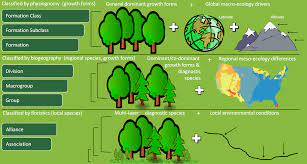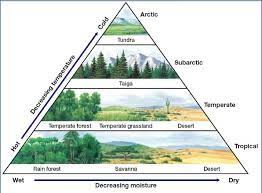RELIEF
- Books Name
- Learn with me Social Science Book
- Publication
- Learn with me publication
- Course
- CBSE Class 9
- Subject
- Social Science
Natural Vegetation and Wild Life
- With over 47,000 plant species, India occupies tenth place in the world and fourth in Asia in plant diversity. It includes 15000 or 6% of the world’s total flowering plants.
- India is one of the twelve mega biodiversity countries of the world.
- India has 89,000 species of animals as well as a rich variety of fish in its fresh and marine waters.
- Plant community which grows naturally with no human help and is not disturbed by humans for a long time is teemed as natural vegetation.
- The term flora denotes plants and fauna denotes species of animals in a specific region.
- The natural vegetation which has been left undisturbed by humans for a long time is called virgin vegetation.
- Virgin vegetation which are purely Indian are known as endemic species and those which have come from outside India are termed as exotic plants.
Factors determining flora and fauna in a region are as follows.
Relief
- The nature of land influences the type of vegetation. It includes mountains, plains and plateaus as well as dry and wet regions.
- Different types of soils provide basis for different types of vegetation. The sandy, deltaic and other types soils support different types of vegetations.
Climate
- Temperature, photoperiod, and precipitation are the three climatic factors which determine natural vegetation.
- The character and extent of vegetation are mainly determined by temperature along with humidity in the air, precipitation, and soil. As per temperature, the vegetation types differ from tropical to subtropical and alpine.
- Period of exposure to sunlight varies for different plants leading to their different rates of growth. Due to longer duration of sunlight trees grow faster in the summer.
- Areas of heavy rainfall have more dense vegetation as compared to other areas of less rainfall.
- Forests are renewable resources and play a major role in enhancing the quality of the environment. They modify local climate, control soil erosion, regulate stream flow, provide livelihood for many communities.
- It controls wind force and temperature and causes rainfall.
- Vegetation in most parts of India has been modified at some places or replaced or degraded by human occupancy.
Ecosystem
- All the plants and animals in an area are interdependent and interrelated to each other in their physical environment, thus forming an ecosystem.
- Human beings are integral part of ecosystem.
- The greed of human beings leads to overutilisation of resources.
- A very large ecosystem on land having distinct type of vegetation and animal life is called a biome.

TYPES OF VEGETATION
- Books Name
- Learn with me Social Science Book
- Publication
- Learn with me publication
- Course
- CBSE Class 9
- Subject
- Social Science
Types of Vegetation
- The major types of vegetation in India are Tropical Rainforests, Tropical Deciduous Forests, Tropical Thorn Forests and Scrubs, Montane Forests and Mangrove Forests.
- With warm and wet climate all year round the Tropical Rainforests have luxurious trees, shrubs and creepers. The rainfall is more than 200 cm.
- The are restricted to heavy rainfall areas of the Western Ghats and Island groups, upper parts of Assam and Tamilnadu.
- A large variety of animals are found in the rainforests.
- The most widespread forests of India — the Tropical Deciduous Forests — are also known as the Monsoon Forests. Rainfall ranges between 200 to 70 cm.
- On the basis of the availability of water, these forests are further divided into moist and dry deciduous forests.
- These are spread across northeastern states, foothills of Himalayas, Jharkhand, West Orissa, and Chhattisgarh and eastern slopes of Western Ghats.
- Lions, tiger, pig, deer elephant, variety of birds, reptiles are found here.
- The leaves of vegetation in Thorn Forests and Scrubs are mostly thick and small to minimize evaporation and have succulent stems to conserve water. Rainfall is less than 70 cm.
- These forests are found in Northwestern part of the country and semi-arid areas of Gujrat, Rajasthan, M.P. Chhattisgarh, U.P., and Haryana.
- Common animals found are rats, mice, rabbits, fox, wolf, tiger, lion etc.
- Montane forests have a succession of natural vegetation belts in the same order as we see from the tropical to the Tundra region.
- Wet temperate forests are found between a height of 1000 and 2000 meters while temperate grasslands are found at higher elevations above 3600 meters and give way to alpine vegetation.
- At 3600 meters above sea level, temperate forests and grasslands give way to alpine vegetation.
- The mangrove tidal forests are found in the areas of coasts influenced by tides.
- Dense mangroves are the common varieties with roots of the plants submerged underwater.
- Delta regions of major rivers have such vegetation.
- Royal Bengal Tiger is famous animal of these forests.
- India has more than 1200 species of birds, 2500 species of fish and between 5 to 8 percent of the world’s amphibians, reptiles, and mammals.
- India is the only country in the world that has both tigers and lions.
- The Himalayas have a large range of animals that survive the bitter cold.
- Every species of animal has a role to play in the ecosystem; hence conservation is essential.
- Hunting and pollution is causing threat to animal species.
- To protect the flora and fauna of the country, the government has taken many steps.
- Fourteen biosphere reserves have been set up in the country to protect flora and fauna.
- 89 National Parks, 49 Wildlife Sanctuaries and Biosphere Reserves have been set up to take care of natural heritage


 Learn with me publication
Learn with me publication
